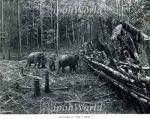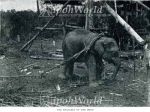We've tried to ensure the information displayed here is as accurate as possible. Should there be any inaccuracies, we would be grateful if you could let us know at info@ipohworld.org . All images and content are copyright.
(Please click on the thumbnail for a bigger image.)
Elephant Catching - Part 1



Since the early nineteenth century elephants have been a common sight in the Malay Peninsula as well as a constant nuisance to villagers whose crops and gardens were rampaged by these mammoths. Traditionally across Malaya, elephants were a mode of personal transport and the prerogative of Royalty. Indeed they were part of the official regalia of the Sultan, but as they were also the best means of transporting heavy tin ore, they were often rented out to the mines by both Royals and commoners alike. Once the British Resident was established in Perak, he too took to using elephants when visiting remote parts of his domain as did the various District Officers in the remote areas of the state. Consequently in the early days there was a great need for elephants to be caught, tamed and trained to become useful beasts of burden. However as more modern transportation became available the role of the elephant was reduced although Perak, being one of the later states to be developed continued to use elephants for many years.
An article entitled “Elephant Catching” from The Strand Magazine London (a magazine which started in 1891) in April 1895 chronicles how these creatures were caught and held in captivity in Perak. The above photographs and those at Part 2 are taken from this article.
On the day in question the village elders headed by the Malay Chief and aided by the Pawang (medicine man) decided to capture a herd of 15 elephants which had regularly come close to the village. An inclosure or kubu as it is known in Malay was set up for this purpose.
The building of this kubu takes place after much preparation with the help of some Malays and Sakais (an impolite name for an aborigine race in the interior of the peninsula). The materials are taken from the surroundings and soon a trap is created by a steep spur. A vivid description is written in the article of how the inclosure is erected. The author also includes a detailed explanation of how 12 of the 15 elephants are driven into the Kubu, amidst the difficulties caused by the steep and dangerous terrain, coupled with the mistakes made by the trackers and beaters. The remaining three escaped.
The whole process is completed in a few minutes but the elephants which are caught try repeatedly to break free from their prison in the middle of the jungle. They are denied food for three days except for what is found in the inclosure. As the initial work of capturing these beasts is done, necessary arrangements are made to transfer them to the stocks or ‘chelong’. This is where the animals are trained and educated. To do this, the elephants are secured with heavy ropes of which one end is tied to a tree inside the ‘kubu’.
A platform where a couple of men are stationed is suspended at a height of 20 feet. These men hold light lines which are attached to a noose and are able to lift it off the ground once the elephant has entered the trap. Then the herd is enticed by some plantain stalks towards the trap. The bait is taken and when one of the animals places its foot in the noose, it is then drawn up and the rope is tightened which prevents the elephant from bolting off. The elephant puts up a fight and struggles to break free. This continues while the rest of the herd is at the far end of the stockade.
Tame elephants are then brought into the ‘kubu’ to aid in approaching the captive whose forelegs are tied in such a position to prevent further injuries. These tame elephants are important in the process of bounding the wild beast. Finally after much struggle, the wild elephant gives in and falls to the ground refusing to stand up. The medicine man is summoned to perform his wiles and when the animal eventually arises, the credit is given to him. Now it must be taken to the ‘chelong’ which is built on a river bank.
A tame elephant is harnessed to the captive with ropes attached to its trunk. The latter starts off well but eventually becomes angry and dashes into the jungle dragging behind his unwilling ‘partner’. Its escape is successfully flawed by the Malays present who seize the leg ropes. The harness is then transferred to a larger tame elephant. Then one of the three elephants still at large crashes through the jungle causing panic among the handlers and the elephants. However the situation is contained soon and the renegade gives up after a couple of tries.
After some resistance the animal is finally taken to the ‘chelong’ which will be his lodging for a few weeks. The ‘chelong’ is built in such a way that it allows very limited movement for its captive. The twelve elephants are each brought here and this takes about three weeks. A couple of Malays are put in charge of each of these animals upon arrival to feed, wash and educate their charge. The elephants eventually become accustomed to the captors.
Any sores and wounds are treated and the elephants, still coupled together, are taken to a nearby river to bathe, mounted by a driver or ‘gembala’ who gives it the first words of instruction impressing their meaning by using a ‘kwasa’ which is a sharp iron hook to guide him. Once these wild captives have learnt these words, the tame elephants are no longer needed. When the work of breaking him in is completed, the elephant is taken to his master’s village and remain there for a year before he is sent to do hard labour in the tin mines.
They are used to carry rice and provisions to the miners and bring back the hard-earned tin ore to the nearest depot. A decade ago from 1895, a large elephant in Perak would fetch a handsome price but the price has dwindled due to the advancement of civilization which has brought such improvement in transportation. This has reduced the need for the services of these gentle giants that so freely roam the jungles of the Peninsula. (Remember this was written in 1895)
The photographs show from left to right; some of the beaters outside the "kubu" fence, next; the captives in the "kubu" and lastly the smallest of the herd.
To go to Part 2, click here.
To read about the history of Ipoh's transport in e-Book form, click here.